For the third time in three years the Confederates invade the north through Maryland. The first ended in Antietam, the second in Gettysburg. The goal this time? The capture of Washington, DC.
The Stage
Grant pursued his very costly Overland Campaign as he sought to crush Lee’s Army in Virginia. He drained the forces around Washington to replace the huge amount of casualties. In fact, he reassigned the veterans who manned the heavy artillery in the Washington defenses to infantry duty in his campaign. Now he sparred with Lee near Petersburg, south of Richmond.
Hunter, another Union general, slashed and burned his way up through the Shenandoah Valley and approached Lynchburg. Lee dispatched Jubal Early and 8000 men to defend Lynchburg. While Hunter surrounded Lynchburg, Early had tons of empty trains sent into the city, whistles blowing and his men cheering loudly at each arrival. Hunter, thinking he was facing a massive Confederate force, turned tail and ran. Early chased Hunter out of the Shenandoah Valley creating a corridor to a minimally defended Washington. As Early marched down the Valley his army swelled to 15,000.
Enter Lew Wallace
Lew Wallace commanded the only Union army standing between Early and Washington DC; and a rag tag force at that, a force from which Grant had siphoned the best to his Overland Campaign. Mostly national guard and 100 day soldiers. They had relegated Wallace to the Middle Department in Baltimore, largely an administrative position. And now he was Washington’s only hope.
Lew Wallace had been a rising star, the youngest major general in the Union army. The battlefield was in his blood. His quick action at Fort Donelson had turned around a retreat of the Union’s right flank. So what happened?
Wallace’s biggest failure as a general was not going to West Point. At the battle of Shiloh the death toll astounded the North. Halleck and Grant received all kinds of flack. So they decided to dump on the non-West Pointer, Lew Wallace. He didn’t get to the field during that first day of battle. So it was his fault. Never mind that Grant did not write down his orders so there was confusion over which route Wallace should take. Never mind that Wallace showed up where Grant should have been. The enemy had pushed Grant back. Wallace had to backtrack and show up at Grant’s retreated position. Never mind that he was the first on the battle field the next morning. Never mind that he had a low casualty rate because he ordered his men to hit the dirt before every Confederate volley. He was not West Point. He was to blame.
Veni, Vidi, Vamoose
Relieved of field command Wallace, back in his home state of Indiana, canvassed the state raising enlistments for Indiana’s quota. Confederate General Kirby Smith invaded Kentucky. He sent one of his brigades, under Henry Heth, to take the unprotected city of Cincinnati, just across the Ohio River. Out of options the Union command ordered Wallace to do the impossible – protect Cincinnati. And he only had two weeks to prepare. And only 200 regular troops and 1500 home guards. Heth marched with at least 10,000 battle-hardened troops.
Wallace met with the mayor of Cincinnati, and the mayors of Covington and Newport, the two Kentucky towns just across the river. If these towns were captured, artillery would obliterate Cincinnati. He declared martial law. The people who could fight would form a militia, those who couldn’t would dig the batteries and breastworks across the hills of Covington and Newport. To augment the construction Wallace employed “The Black Brigade”, the first organization of freed blacks for military purposes. Without them the breastworks and batteries could never have been completed in time.
He then put out a call to the entire state for armed volunteers. And the “Squirrel Hunters” showed up, by the tens of thousands. If you could shoot a squirrel out of a tree, you couldn’t miss a man. They might not be much good in the open field with no training, but in the rifle pits of the breastworks, behind the trees near river fords, and from the decks of the impromptu patrol boats, they could prove deadly.
Ten days later Heth approached Cincinnati. The next day they skirmished up and down the lines. Then in a thunderstorm that evening they retreated. They came, they saw, and they skedaddled. Or as Wallace reported, “The skedaddle is complete.”
Monocacy
And now the savior of Cincinnati would try his magic for Washington DC.
And why was he all alone? Garrett, the president of the B&O Railroad, watched Early move north down the Shenandoah Valley with growing concern. His railroad was at risk. He telegraphed Halleck in Washington, who was now Chief of Staff. Halleck, then, forwarded the message to Grant down near Petersburg.
The Wonders of West Point didn’t think there was a problem. Grant insisted Early was still down near Petersburg. What was he smoking? Or, more to the point, drinking? Even after the commander at Harpers Ferry wired Washington that a large Confederate force marched down the Shenandoah Valley, Grant continued to believe Early was down near him.
Giving up on the West Pointers, Garrett turned to Lew Wallace in Baltimore, who listened and immediately took action. He moved his motley crew, under his subordinate, Tyler, also exiled to the Middle Department, to Frederick. Well, the B&O did. Garrett’s big concern was Monocacy Junction and the railroad bridge crossing the Monocacy, just east of Frederick. They were joined by Clendenin and his experienced cavalry, who had been patrolling along the nearby Potomac.
After a week had gone by, and Harpers Ferry forces had retreated to Maryland Heights, Grant finally woke up, yeah, Early was not down in Petersburg. He sent a division of VI Corps, under Ricketts to reinforce Harpers Ferry. they traveled by steamer from southern Virginia to Baltimore. The B&O moving them from Baltimore to Harpers Ferry tracked right through Monocacy Junction. Wallace convinced them this was where they were needed and later Halleck confirmed it.
So now the stage was set:
- Clendenin: doing the recon and guarding the many fords
- Tyler: on the right flank defending Stone Bridge also called Jug Bridge and adjacent fords
- Wallace: in the middle defending Monocacy Junction and the adjacent railroad bridge
- Ricketts: on the left flank defending the Covered Bridge and later Worthington Ford
The last piece of the puzzle. Wallace deployed some of his troops, especially the cavalry to Frederick and Cotactin Mountain. But as he saw Early’s forces pouring over the gaps of South Mountain (you could see the dust from the marching), he ordered the troops back to the Monocacy and reported the advancing columns to Halleck. This lit a fire under Halleck, who got on the wire to Grant. Grant sent the rest of VI Corps to defend Washington. But that would take a couple of days. Could Wallace, with his 6,500 men, slow down Early, with his 15,000 battle hardened troops, and delay them long enough for VI Corps to arrive?
Jug Bridge
The Stone Bridge, called Jug Bridge, is long gone, collapsing in 1942. The National Pike crossed Jug Bridge, and it couldn’t stand up to the onslaught of automobiles. So when you cross it today – not much to see. To the right, beyond the jersey wall and at a lower level is an older steel bridge. If you walk along the banks, to the right of the old steel bridge you can see the stone abutments of the old Jug Bridge.
Jug Bridge was named after the jug-like structure adorning the east end of the old bridge, allegedly containing a jug. Shadow Spirit finds the small park where they moved the Jug.
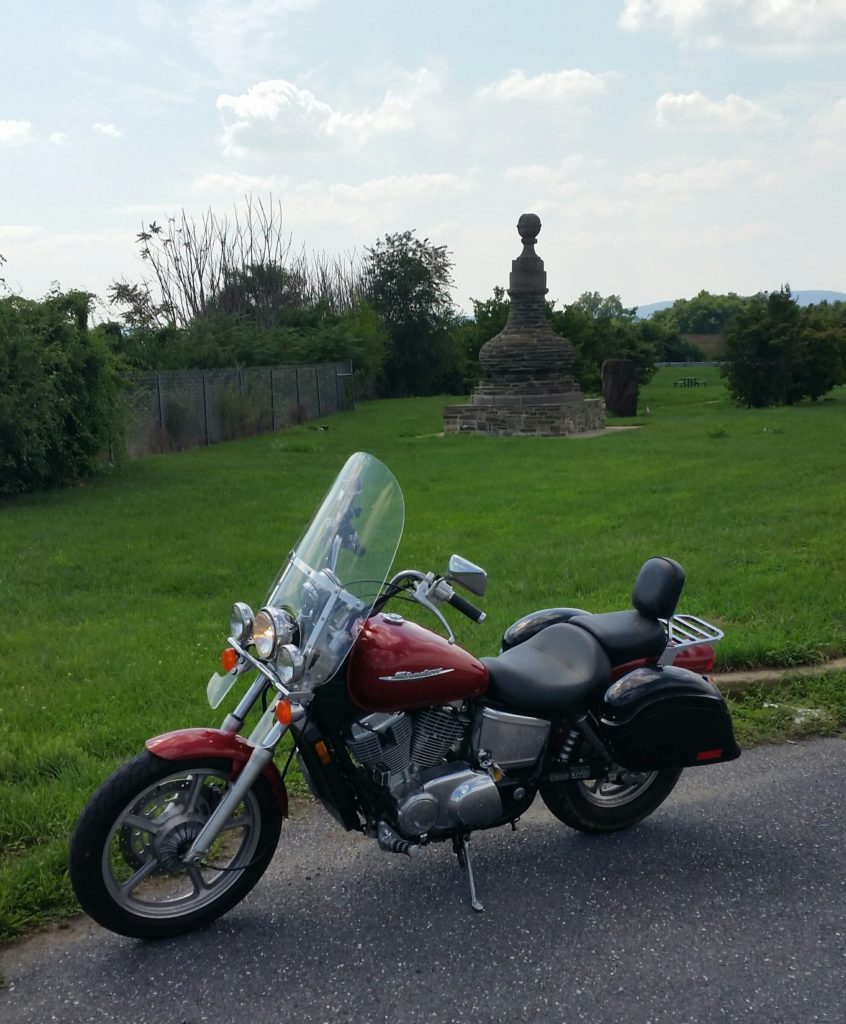
General Tyler had the job of defending Jug Bridge, which was well north of the main area of fighting. The National Pike, the road back to Baltimore crossing the bridge, had to be held at all costs. It was the Union escape route. When the army retreated, Tyler held it until the rest of the Union forces reached it.
Covered Bridge
The Covered Bridge no longer exists. In fact, Wallace torched it in mid-afternoon, when his troops got spread too thin. One less Monocacy crossing to defend. This truss bridge replaces the Covered Bridge, and carries the Urbana Pike, which used to be called the Georgetown Pike.
As Shadow Spirit heads east, the first bridge in the video crosses the railroad tracks. Monocacy Junction is just to the left. So the Covered Bridge and the railroad bridge crossing the Monocacy were close to each other.
Looking westward past the truss bridge, you can see the bridge crossing the tracks. The railroad bridge is out of sight to the right and around the river bend.
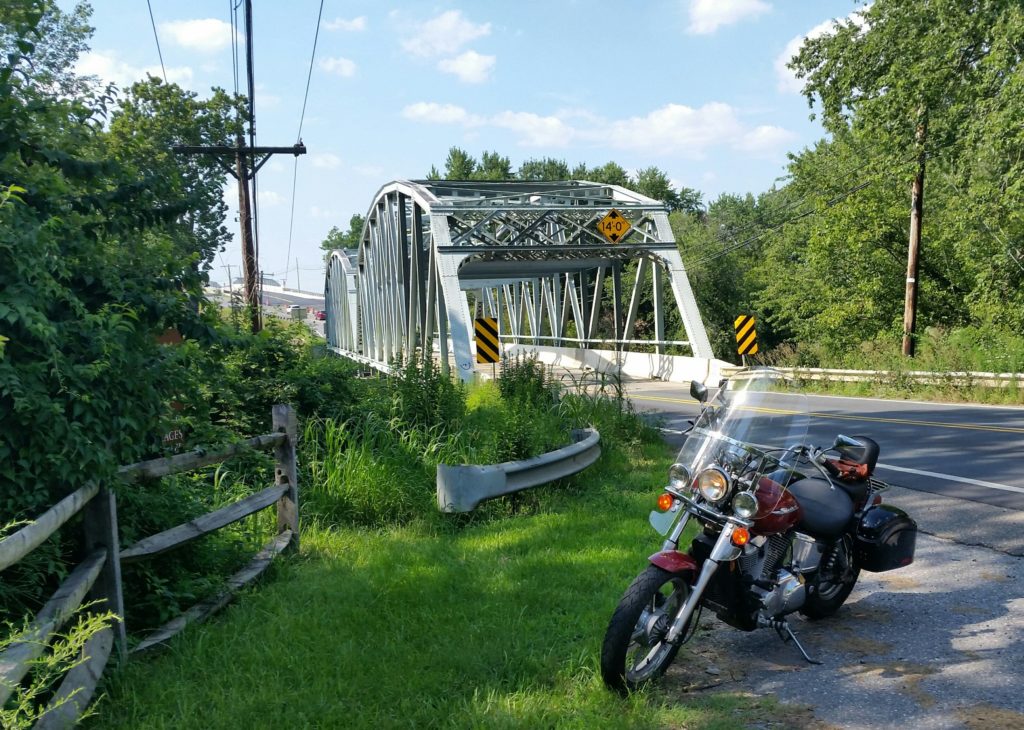
The Covered bridge carried the Georgetown Pike, the direct route to Washington DC. Wallace set up his headquarters on the high ground east of the railroad bridge. He deployed some troops along the tracks on the west side of the bridge to defend the Junction. Rickett’s veteran division on the east bank with Wallace guarded the Covered Bridge.
When the Confederate cavalry found the Worthington Ford south of the Covered Bridge and crossed the Monocacy, Wallace ordered Rickett to blunt that offensive. Short of troops and facing an ever increasing enemy, Wallace brought back most of the men defending the Junction and gave the command to fire the sheaves of wheat already strategically placed in the Covered Bridge. Some of the troops who missed the order to retreat had to scramble back across the railroad bridge.
Worthington Ford
Just beyond Shadow Spirit is the Worthington Farm House, which afforded a staging area for the Confederate cavalry after crossing the ford. Eventually the infantry set up an artillery battery there.
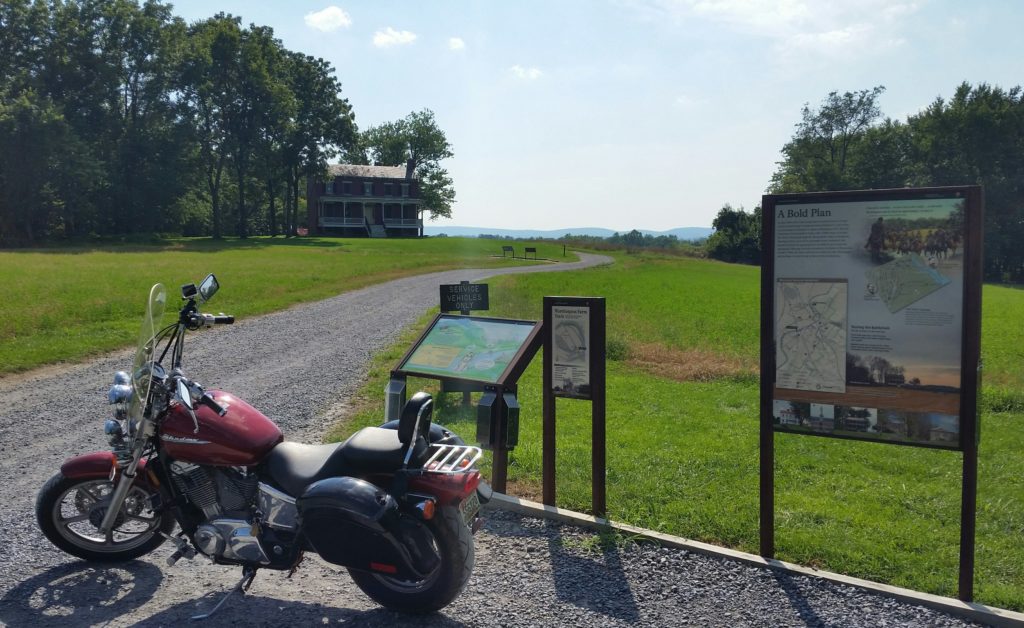
Behind Shadow Spirit is the Thomas farm, adjoining the Worthington farm. Beyond the farm is the cornfield fence where Rickett’s brigades set up their defensive position.
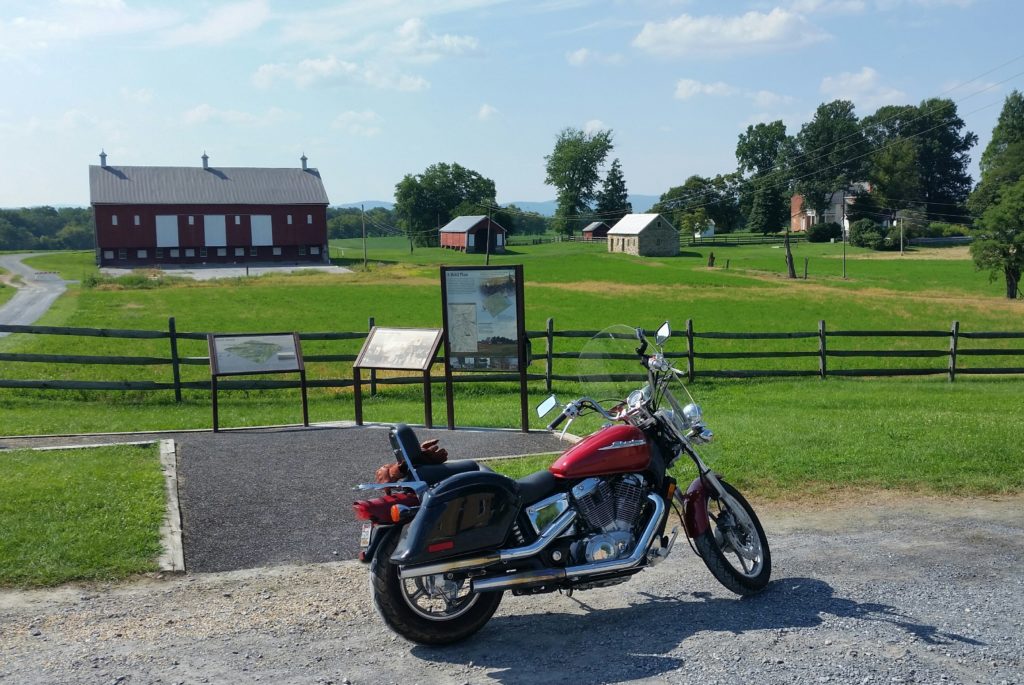
The Confederate cavalry charged Rickett’s entrenched troops, twice. Both times they were repulsed with heavy casualties. Finally a Confederate infantry brigade, which that morning had returned from Harpers Ferry, waded the ford and engaged Rickett’s troops. After hours of intense fighting, late in the afternoon, the Confederates began to gain the ascendancy. It was time for Ricketts, Wallace and Clendenin to retreat to the National Pike. With Tyler bringing up the rear and keeping the Confederates at bay, they skedaddled.
Fort Stevens, DC
Shadow Spirit hugs the curb by Fort Stevens within the District of Columbia. Due to the angle and the cropping, it almost looks rural. You can see some of the cannon in the background. The boulder directly above Shadow Spirit’s windshield and on the skyline is the “Lincoln Under Fire” monument placed by VI Corps.
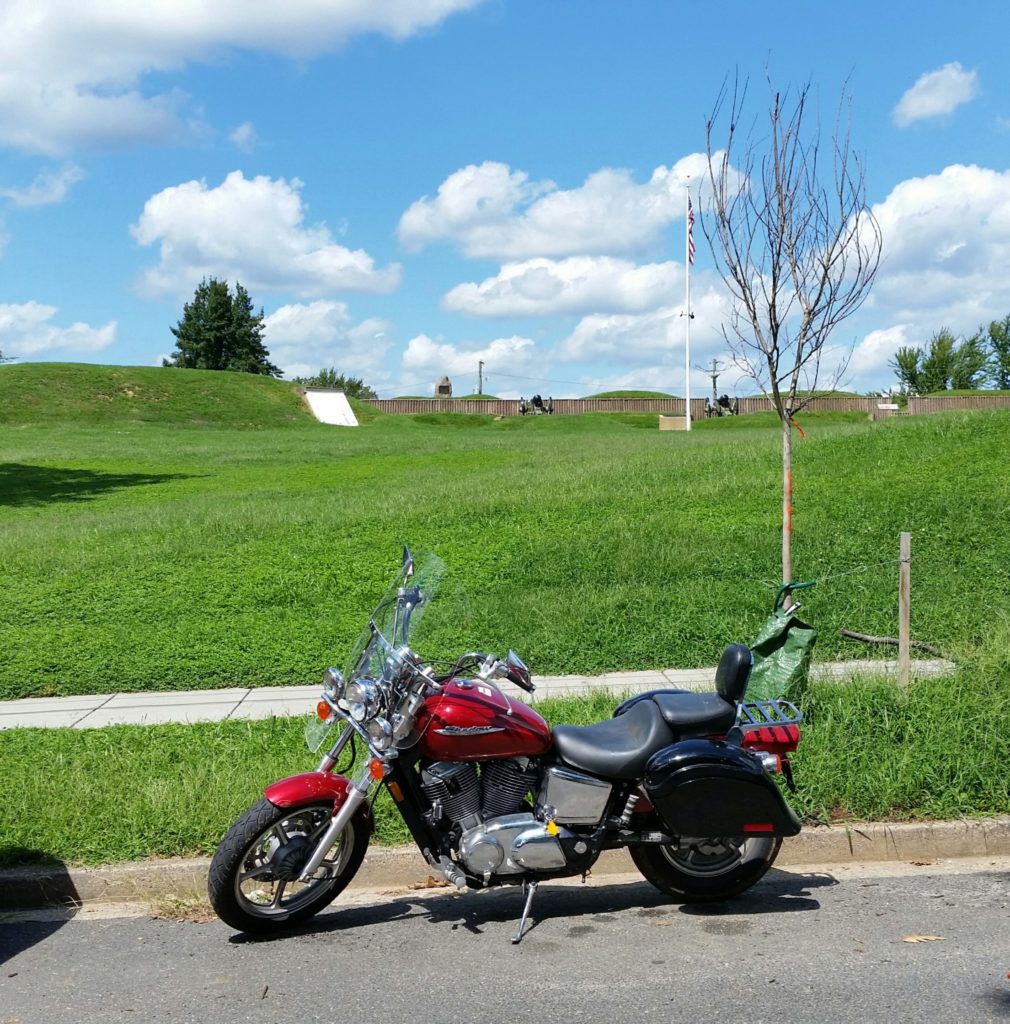
When Early reached Washington, the inexperienced troops manning the strong fortifications around DC commenced firing. As one Confederate put it, “we have never seen artillery used with such poor effect.” But the steamships carrying the rest of VI Corps were arriving. Soon the green troops manning the defenses were augmented by veterans. The artillery became much more effective. Skirmishing continued through the day.
During the afternoon the sound of skirmishing proved too much for Lincoln. He had to visit Fort Stevens. The story is that Oliver Wendell Holmes saw a tall civilian standing on the parapets of Fort Stevens and yelled, “Get down, you fool!” The history is that the man standing next to Lincoln was shot in the leg.
With VI Corps firmly in place, Early realized that he was too late. And he skedaddled.
What happened to Lew Wallace? Monocacy was his last battle. But if you have read or seen “Ben-Hur”, you know he didn’t disappear into obscurity.
Final Resting Place
Just a bit north of the Monocacy Battlefield and east of Jug Bridge, Mount Olivet Cemetery provides a final resting place for Confederate soldiers, along with cemeteries in Hagerstown and Shepherdstown. These are the dead from Monocacy, as well as, South Mountain and Antietam. Below Shadow Spirit rolls along the long line of Confederate tombstones on the left.
These soldiers have names, but many had no name for a tombstone. They were buried in a mass grave. In 1880 the ladies of Frederick County erected a marble monument on that mass grave to memorialize those unnamed men, not generals, but those unknown soldiers. For 140 years it stood watch over the dead.
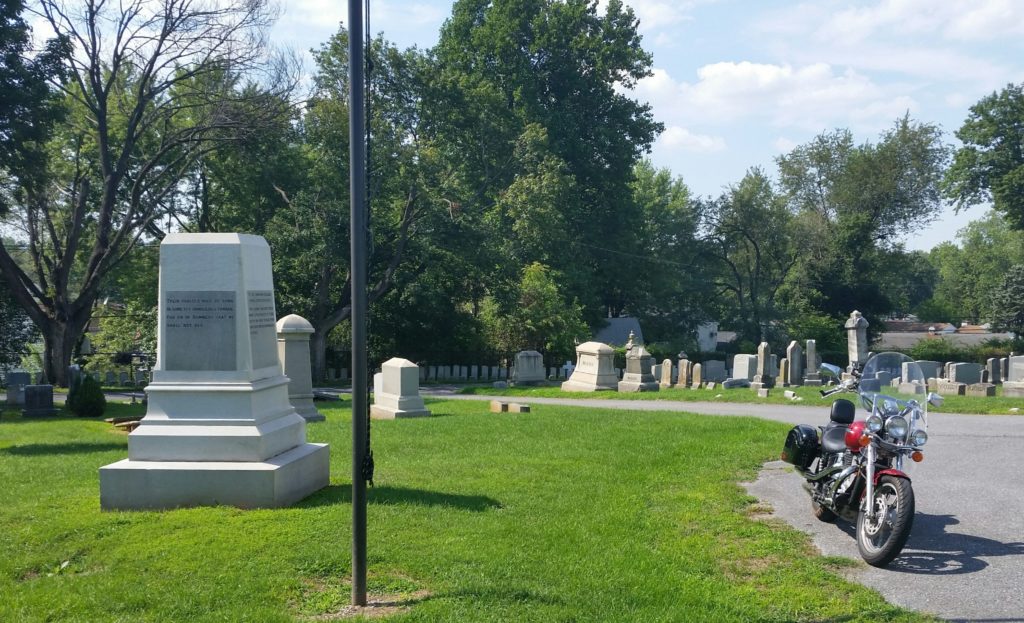
Two months ago vandals tore down, beheaded, and desecrated with red paint that nameless soldier. You see here the remaining base and its attendant bare flagpole. In the background, near the trees you can see that long line of tombstones. Certainly statues to Confederate generals should not be forced on people in the public square. But I am not sure we should disturb the sleep of the dead. Who knows what might come of that?
“If charnel-houses and our graves must send
Those that we bury back, our monuments
Shall be the maws of kites.” Macbeth 3:4
Reading note: “Determined to Stand and Fight” is the Emerging Civil War Series volume that covers Antietam. Gail Stephens has written an excellent book “Shadow of Shiloh” on Lew Wallace’s Civil War career.